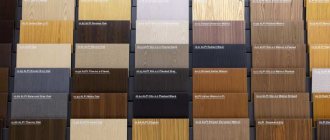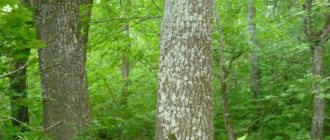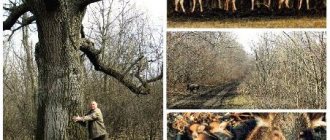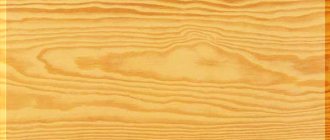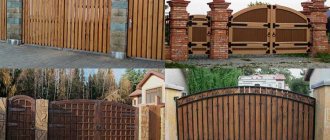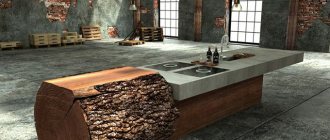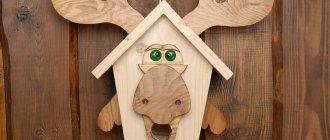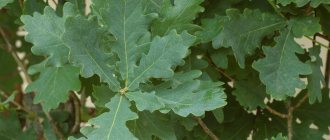Oak is a very massive tree that grows in forest and forest-steppe zones, forming large oak groves. Many peoples worshiped these trees, poets in their legends compared their heroes with them. A.S. remembers the oak tree. Pushkin in his works, calling this symbol of longevity “the patriarch of our forests.”
Craftsmen have always admired the amazing properties of oak wood. Oak is still considered one of the most valuable building materials, despite its high cost. Let's talk about the features and advantages of oak wood.
Characteristic
The lifespan of an oak tree sometimes reaches 1000 years, and the trunk diameter can be 2 meters or more. The quality of wood is affected by the age of the tree; it increases simultaneously with the age of the oak.
Oak lumber was held in high esteem by our ancestors. They believed that the best frame for a well is made of oak wood; the water there is always clean, cold, and does not “bloom.” The peasants bent runners and rims from oak, made a stupa, barrels for wine and pickles, and furniture. The piles in the river were also oak.
Oak wood is very durable, it is quite difficult to cut, but it bends well. Oak that is at least 150 years old is suitable for the production of joinery. The most revered characteristic of this tree is its frequent heart-shaped rays, which gives oak products a refined and beautiful appearance.
Giant oak
Oak is a genus of trees in the beech family, numbering more than 600 species. Oak is distributed in the Northern Hemisphere of the globe - from Finland to northern Africa and South America. In Russia, the main species that grow is the English Oak, known for its size (up to 40 m in height and 1.5 m in diameter), tent-like spreading crown of branches with carved leaves and bitter (due to the saturation with tannins) acorns.
Peculiarities
Oak is considered the leader among deciduous trees in terms of strength, elasticity and flexibility. He gained universal recognition among carpentry masters.
Summer oak wood is especially valuable, namely the one that is located closer to the core. The strength and extraordinary strength of the tree is explained by the fact that only the outer ring participates in its life processes. The inner layers of oak remain passive, gradually turning to stone.
Oak wood does not warp and is resistant to cracking. This material is never affected by mold. Harmful insects cannot cause harm. Resistance to such impacts increases from year to year.
Oak wood color
Oak wood is porous, its texture is very beautiful. The color can be light, brown, yellow or yellow-brown. The color of the sapwood part of oak wood is light yellow. Over time, the color becomes darker and the wood takes on a noble appearance.
A non-professional will be able to tell by looking at the texture and shades that the wood is mature. The texture becomes more colorful if it is kept in water for a long period. This process is called staining and can last for decades. As a result, the color of the wood becomes more intense, much darker, and the material itself becomes stronger.
Advantages
The main advantages of oak wood are:
• During operation it does not emit resin and will not harm the health of others.
• Greater wear resistance.
• Durability. Natural dry edged oak boards can withstand significant loads and perform any task.
• Practicality, long service life, reliability.
• Resistance to rotting, resistance to moisture and biological influences. Insects do not like oak.
• Environmentally friendly, lack of toxic impurities.
• Healing properties. Oak has the ability to replenish a person’s strength, improve general condition, cure diseases of the nervous system, blood circulation, and chronic diseases of internal organs. It refers to “donor” trees.
• Easy to care for. Oak wood can never cause grief due to scratches; it always remains decorative and attractive in appearance.
The disadvantage of oak wood is the high price of the material. But if you recalculate for the period that it will serve, the cost will turn out to be profitable.
Popular names for dubik, ladny dak, nelin.
The Russian name “oak” comes from the ancient Slavic “main tree” and is given for strong wood and longevity. Another name for oak among the ancient Slavs is “Perunovo tree”; figurines of this pagan deity were carved from it. Oak healed, warded off evil spells, strengthened the body and spirit. Oak in Russian mythology is a symbol of the world tree, a bridge between the world of the living and the dead, the world of gods and mortals.
The common oak, or pedunculate oak, grows in the European part of the USSR from the Leningrad region in the north to the Crimean and Caucasus mountains in the south, and in the east it reaches the Urals; it is one of the most valuable forest-forming species and reaches a height of 40-50 cm.
In ancient times, many peoples considered living oaks to be a symbol of longevity, power and strength. In Ancient Greece, the oak was considered a sacred tree, Pliny the Elder wrote that oaks have an immortal destiny, it was forbidden to cut it down, and the life of an oak is much longer than a human one and lasts several centuries. The average age is 300-500 years, under favorable conditions it can live up to 2000 years. The Stelmuža oak, growing in Lithuania for about 2000 years, has a trunk circumference of 13 m.
In Europe in the Middle Ages, as a symbol of eternity, an oak wreath with acorns was hung on the door at Christmas.
MORPHOLOGICAL DESCRIPTION
A strongly branching tree with a huge crown and powerful trunk, 20-40 m high and up to 3 m thick or more.
At the age of 100-200 years, height growth stops; The increase in thickness continues throughout life. The root system consists of a very long taproot and lateral roots.
Young oak trees have gray, smooth bark; in the 20th year, cracks form on the bark; old trees have bark up to 10 cm thick.
The leaf arrangement is alternate, at the top of the branches in the form of bunches, the leaves are oblong-obovate, pinnately lobed, large (40-150 mm long, 25-70 mm wide), with four to seven lobes, hard, almost leathery, dark green above, shiny, green below, with short petioles.
Flowers are dioecious. Flowering begins at the age of 40-60 years, along with the blossoming of leaves - usually in May. The plant is monoecious. Staminate flowers are collected in long hanging catkins 20-30 mm long, with ten or more flowers; female flowers are usually located on young shoots higher than male ones, collected 2-3 together on a separate reddish stalk. The fruit is a nut. Each ovary usually develops only one acorn; acorns usually hang in pairs.
CHEMICAL COMPOSITION
The young bark contains up to 20% tannins, flavonoids (quercetin, etc.), gallic and ellagic acid, phlobafen, pentosans, pectins, sugars, mucus, proteins, starch. Acorns contain starch, tannins and proteins, sugars, and fatty oil. Tannins quercetin and quercetin, pentosans were found in the leaves. The tannin content in wood is 4-6%.
APPLICATION
English oak is a timber, medicinal, phytoncidal, food, melliferous, dyeing and ornamental plant. Oak leaves contain the pigment quercetin, which dyes wool and felted products yellow, green, chartreuse, brown and black. In the old days, growths on oak leaves caused by gall midges were called “ink nuts”; ink was made from them.
A long-lasting dye for carpets and tapestries is obtained from the bark.
In Russia, oak bark was used for tanning leather, hence the name itself - tanning. Oak is used to produce tanning extracts for the tanning industry. Barrels for cognac, wine, beer, vinegar, oil are made from oak wood; the tannins contained in the wood give drinks a special taste and aroma.
Oak brooms in the bathhouse are valued on a par with birch brooms; they are believed to normalize blood pressure.
Acorns are loved by domestic pigs and many wild animals. Acorns contain a lot of starch; in times of famine, ground acorns were added to bread.
Amirdovlat Amasiatsi (15th century) wrote that crushed acorns stop bleeding, and a compress of boiled acorns stops the growth of breast tumors.
The book “Cool Vertograd” (XVI century) describes the astringent and hemostatic properties of oak. There is also a description of the use of an infusion of oak leaves: “Water from oak leaves is drained, and with that water we wash our face and hands and clear our eyes, remove all kinds of fiery pimples and the outflow of the eye will draw out... the same water is taken in the morning and evening for 9-13 spools (40 -50 g), then the blood will be expelled from the inside, which happens from a blow or bruise... Having soaked the handkerchiefs, he applies them to the ulcers and heals them... and the fire and heat are removed from the body.”
In scientific medicine, the bark of young oak shoots is used. Tannins (tannins) are used as astringents, anti-inflammatory, antiseptic, anti-putrefactive and hemostatic agents. Recommended for diseases of the liver and spleen, excessive sweating of the feet, bleeding in the gastrointestinal tract, heavy menstruation, poisoning with mushrooms and heavy metals.
A decoction of oak bark is used to rinse the mouth for inflammation of the mouth, gums and throat, bad breath, and for enterocolitis, inflammation of the urinary tract and bladder, and for diseases of the liver and spleen, drink infusions orally. For burns, the decoction can be used for compresses.
In veterinary medicine, oak bark is widely used as a remedy for stomach disorders.
Fresh crushed leaves are applied to ulcers and wounds, powder from dry leaves is sprinkled on wounds. Dried and ground acorns are used for bladder disease and diarrhea.
Infusions and decoctions of oak leaves are drunk for diabetes.
A coffee surrogate is prepared from acorns - a nutritious and healing drink, helps with gastrointestinal diseases, rickets, anemia and scrofula in children, is useful for nervous patients, diabetes mellitus and heavy menstrual bleeding.
Oak bark decoction : 20 g (2 tablespoons) pour a glass of boiling water, and heat in a water bath for 30 minutes, cool at room temperature for 10 minutes, filter, squeeze out the raw materials, add the volume of the decoction to 200 ml, use for rinsing the mouth and throat up to 8 once a day. Drink a tablespoon 3 times a day.
Tincture for heavy menstruation: pour 50 g of oak bark powder into 1 liter of red wine, leave for 24 hours, strain. Drink a tablespoon 3 times a day. Used for vaginal tamponing: a tablespoon of tincture heated to 35°C.
Collection for constipation complicated by hemorrhoids : oak (bark) 30 g, flaxseed 30 g, chamomile 40 g. The components are mixed, 20 g of the collection is poured with boiling water, kept in a water bath or in a thermos for 30 minutes, filtered, the raw materials are squeezed out, volume The broth is added to 200 ml. Drink a tablespoon 3 times a day.
In folk medicine, a decoction of the bark is also recommended for indigestion; it is used to wash festering wounds, give baths for hemorrhoids, etc.
Bath mixture for hemorrhoids : oak bark 50 g, horsetail 20 g, valerian root 30 g. The components are thoroughly mixed, kept in a water bath for 30 minutes, the finished, strained broth is poured into the bath.
Gargling for throat cancer: 15 g of oak bark, pour 1 liter of water, cook over low heat for 30 minutes, add 4 tablespoons of honey, bring to a boil, strain. Gargle up to 10 times a day. Store in a dark place. At the same time, take oak bark powder on the tip of a knife 3 times a day.
Rinse for diseases of the oral cavity: pour 50 g of oak bark into 1 liter of water, boil for 20 minutes over low heat, strain, add 2 tablespoons of medicinal sage, leave for 30 minutes. Rinse your mouth 6-8 times a day.
Preparation of coffee surrogate: peel the acorns, chop, boil until mushy, dry, fry and grind. Boil in milk with sugar, drink 50 g 3 times a day before meals.
COLLECTION AND STORAGE
Oak bark is collected during budding from the stems of stump growth or when cutting down forests, from young trunks of felled trees. You cannot remove bark from growing trees, because... this may lead to their death.
The bark of old trunks and branches, covered with a cracking crust, is not harvested. The young bark has a smooth, crack-free surface. Dry the bark under shelters or in a well-ventilated area.
Acorns are collected in the fall under the trees after they have fallen.
Areas of application
Oak wood is used to create home interiors, build houses and other structures. At carpentry factories, edged and solid boards and slabs are made from oak wood; you can read all about slabs here . The material is in demand and has found application, for example, edged boards are used for interior decoration, and also serve as a frame in the construction of a wooden house.
Oak wood makes beautiful and durable pieces of furniture. In high-traffic areas, the most durable and beautiful material for flooring may be oak boards or parquet. New modern materials do not compete with oak.
Summer oak wood is used in underwater buildings and for the construction of the main parts of wooden floating craft. It makes wonderful souvenirs.
Winter oak wood has found application in furniture production; carpentry and parquet are made from it.
What to consider when making furniture from solid oak yourself
When making furniture from solid wood yourself, you should not immediately take on complex products. Without having the skill of working with wood, it is better to start with simple objects. First of all, it is necessary to draw up a detailed drawing, which will reflect the number of parts and fasteners, their sizes and method of fixation. All these issues need to be worked out at the preparation stage.
Note! It is recommended to purchase the material with a small reserve. It is also worth immediately checking the evenness and quality of drying of the workpieces.
Drawing of a solid wood table
It is easiest to make furniture items from boards, but their appearance will fit organically only into rural interior design. In addition, such furniture will not be durable, since cracks will form between the boards over time on the surface of the prefabricated tabletop. A tabletop glued together from bars has greater strength.
Detailed design of the cabinet drawing
Technological nuances
If your home workshop does not have a circular saw, then cutting the material in accordance with the drawing must be ordered from a specialist, at a furniture factory or in a workshop that provides a similar service. If the parts are simple, rectangular, then you can cut them out yourself using a jigsaw.
The jigsaw file plays an important role when cutting wood
Before cutting out a part, markings are applied to the surface of the workpiece.
When cutting a part with a jigsaw, you do not need to press hard on the tool
It is also worth considering that there are two ways to attach parts to each other: tenon and using fasteners. In the first case, grooves and eyes are cut out and hollowed out in both parts using a chisel, and then the elements are knocked together, having previously treated the fastening points with glue. This fastening method is labor-intensive and requires skill.
The principle of making a tenon joint
Fastening elements include:
- Self-tapping screws.
- Furniture bolts.
- Confirmations.
- Corners.
- Ties.
They make it easier for a beginner to assemble furniture.
Fasteners
Tools
To work with wood you will need a standard set of tools consisting of:
- Saws or hacksaws.
- Jigsaw.
- Planer.
- Chisels.
- Screwdriver.
- Hammer.
- Screwdrivers.
- Clamps.
Necessary tools for making furniture
You will need to purchase accessories depending on the type of product and its design: handles, door hinges, roller or ball guides for drawers, wheels for a bedside table, rods and hooks for the interior fittings of a wardrobe. To finish the surface of the product, you will need to purchase varnish, wood paint, and protective impregnations.
Furniture fittings


